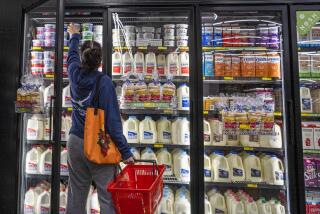Inflation Staved Off for Fifth Month in a Row
- Share via
World events ranging from Asia’s financial crisis to El Nino-related storms combined in February to eliminate for the fifth consecutive month inflation in the prices paid by wholesalers.
Producers such as manufacturers, food processors and refiners last month charged wholesalers 0.1% less for finished goods than the month before and 1.6% less than a year earlier, the Labor Department said Friday.
The February decline followed a 0.7% drop in January, the largest in more than four years. It was the fifth month in a row and the 12th month in 14 without an increase.
“Inflation is the missing actor in today’s economic drama,” said economist Robert Dederick of Northern Trust Co. in Chicago. “The reason for this is that even though the economy is strong, there’s still a lot of excess [manufacturing] capacity.”
Falling goods’ prices, when combined with moderately increasing service prices, have reduced consumer inflation to less than 2%, the lowest level since the 1960s.
And that in turn has permitted Federal Reserve policymakers to keep interest rates low. Going forward, they’re counting on economic weakness in Asia to dampen the U.S. economy, offsetting price pressure from a tight labor market.
A separate Commerce Department report Friday showed that businesses were keeping a tight rein on inventories in anticipation of the slowdown. Inventories were unchanged in January while business sales edged 0.1% lower.
Though February’s price report implied the Fed can hold rates unchanged, bond prices nevertheless turned lower and stock prices yo-yoed as investors locked in profits from earlier in the week. The Dow Jones industrial average closed at 8,602.52, down 57.04 points for the day but still 33.13 points higher than a week ago.
The effects of Asia’s financial turmoil and El Nino showed throughout the price report, but especially in energy costs, down 1.8% last month after a 3.7% drop in January.
However, floods and storms associated with El Nino have drowned vegetable crops in California and helped push food prices 0.4% higher. Vegetable prices climbed 3.9%, including increases of 62.7% for tomatoes and 45.2% for green peppers.
More to Read
Sign up for Essential California
The most important California stories and recommendations in your inbox every morning.
You may occasionally receive promotional content from the Los Angeles Times.









